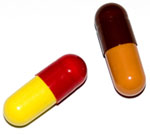Gelatine
Gelatine, known for centuries for its high nutritional value, is highly versatile product. Compared to all the usual hydrocolloids, Gelatine offers a unique combination of neutral taste, easy digestibility, brilliant clarity & reversible setting capacity.
Accepted as a foodstuff & not just as a food additive, this biological product consists almost all i.e. 18 amino acids essential for human nutrition.

Gelatine or Gelatin (from Latin: gelatus meaning "stiff", "frozen") is a translucent, colorless, brittle (when dry), flavorless food derived from collagen obtained from various animal body parts. It is commonly used as a gelling agent in food, pharmaceutical drugs, vitamin capsules, photography and cosmetic manufacturing.
Substances containing gelatine or functioning in a similar way are called "gelatinous". Gelatine is an irreversibly hydrolyzed form of collagen, wherein the hydrolysis results in the reduction of protein fibrils into smaller peptides, which will have broad molecular weight ranges associated with physical and chemical methods of denaturation, based on the process of hydrolysis. It is found in most gummy candy, as well as other products such as marshmallows, gelatine desserts, dips, yogurts and some ice creams. Gelatine for recipe use comes in the form of sheets, granules, or powder. Instant types can be added to the food as they are; others need to be soaked in water beforehand.
Probably best known as a gelling agent in cooking, different types and grades of gelatine are used in a wide range of food and nonfood products: common examples of foods that contain gelatine are are gelatine desserts, trifles, aspic, marshmallows, fruit snacks, jelly babies and confections such as gummy bears. Gelatine is used as a stabilizer, thickener, or texturizer in foods such as yogurt, cream cheese and margarine. It is used in low fat foods to create volume.
Gelatine is used for the clarification of juices, such as apple juice.
